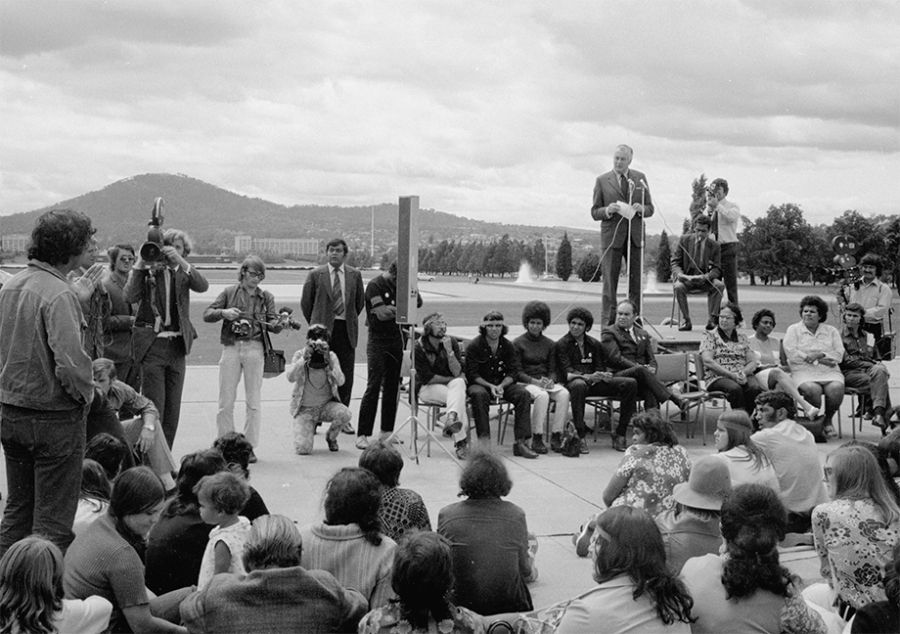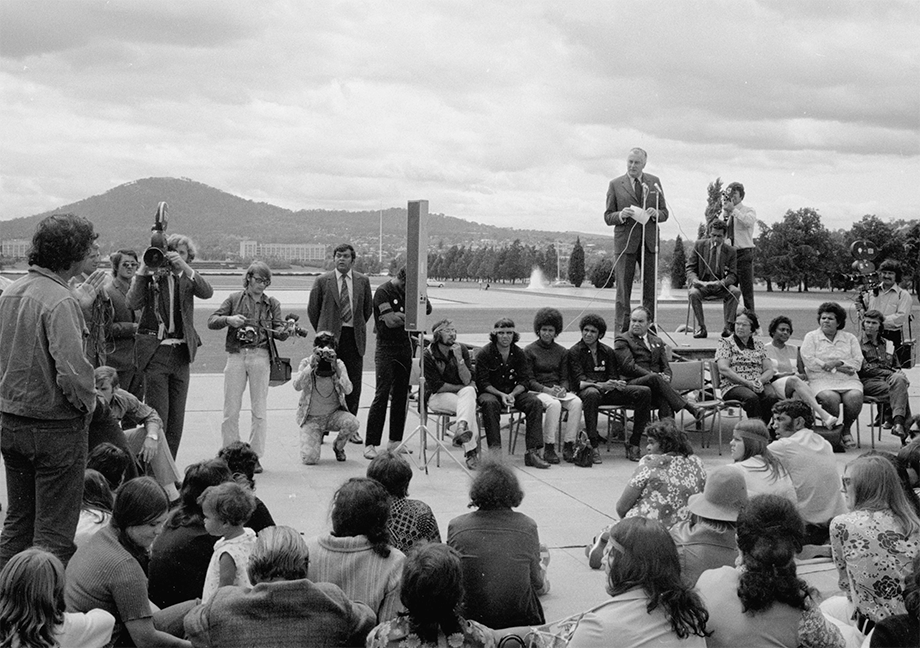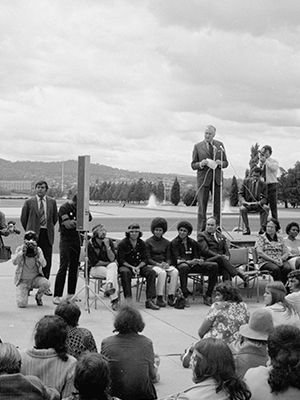
- Free Article: No
- Contents Category: Commentary
- Custom Article Title: ‘Land rights interrupted?: How Whitlam’s dismissal changed the history of First Nations land repossession’
- Review Article: No
- Article Title: Land rights interrupted?
- Article Subtitle: How Whitlam’s dismissal changed the history of First Nations land repossession
- Online Only: No
- Custom Highlight Text:
On the steps of Federal Parliament, a scrum assembled. Reporters jostled for position, enraged members of the public shouted over one another, advisers stood with faces drained of composure – even a comedian was caught in the fray. At the centre stood the tall and imposing figure of Prime Minister Gough Whitlam, listening as the governor-general’s official secretary read the proclamation dissolving Parliament. The moment, instantly mythic, would be remembered as ‘the dismissal’ – the most audacious constitutional rupture in Australian history, one that continues to haunt democratic life half a century on.
- Article Hero Image (920px wide):

- Article Hero Image Caption: Gough Whitlam speaking at the Aboriginal Tent Embassy, Canberra, 1972 (State Library of New South Wales and the SEARCH Foundation via Wikimedia Commons)
- Alt Tag (Article Hero Image): Gough Whitlam speaking at the Aboriginal Tent Embassy, Canberra, 1972 (State Library of New South Wales and the SEARCH Foundation via Wikimedia Commons)
What is less considered is another shadow cast that day. The dismissal derailed a fragile but unprecedented push for Aboriginal and Torres Strait Islander land justice.
Across the road from Parliament House stood another landmark of modern Australian politics. On Invasion Day 1972, a group of young men from Redfern drove overnight to Canberra. In response to a hollow promise on land rights by the William McMahon-led Coalition government, they erected beach umbrellas and then tents on the manicured lawns opposite the national legislature. The Aboriginal Tent Embassy – makeshift, uncompromising – dramatised the sense of being rendered alien in one’s own country. It announced a seismic shift in Aboriginal politics, and in the politics of the nation itself. Thousands came to join. The embassy made plain that land was not merely property but lore, rights, and the ground of self-determination. A version of that embassy endures still, half a century later, reminding the nation of an unfulfilled covenant.
When Whitlam, then the Opposition leader, visited the embassy, he grasped the moment and embraced the new politics of land rights. At the electrified Blacktown Civic Centre in November 1972, with the audience swaying and singing to the anthem of ‘It’s Time’, he declared his vision for a ‘rightful place’ for First Peoples in the life of the nation. His words were not empty.
Within days of his election victory in December 1972, Whitlam began to act. Central to his reforms was a commission of inquiry, led by Justice Edward Woodward, into how Aboriginal land rights might be achieved.
Self-determination, until then little more than rhetoric, began to take institutional shape. A new Department of Aboriginal Affairs, the National Aboriginal Consultative Committee, and mechanisms for Aboriginal organisations to secure housing and services were established. By 1974 an Aboriginal land purchase fund was in operation. Racial discrimination in law was formally prohibited by a set of laws culminating in the Racial Discrimination Act 1975. The Commonwealth, historically content to leave Indigenous policy to the states, asserted itself as never before.
Gestures matched policy. In 1975, at Wattie Creek, Whitlam poured fine red soil into the hands of Gurindji leader Vincent Lingiari. Mervyn Bishop’s photograph captured the moment: a prime minister kneeling, returning land not as a grant of grace but as an acknowledgement of prior sovereignty. From Wattie Creek to Redfern, where government funds supported the purchase of houses on ‘the Block’, Whitlam signalled a commitment to both rural and urban land rights.
By mid-1974, Cabinet had accepted Woodward’s recommendations and begun drafting legislation for the Northern Territory. This was to be the first step, but Whitlam made clear that it was only the beginning. He envisaged a two-stage process. Land rights would come first to the Territory, then extend to the states where Aboriginal people still exercised traditional connection to Country. If necessary, he warned the state governments, the Commonwealth would use its constitutional powers to acquire land and return it.
Here was the audacity – to imagine land rights not as piecemeal concessions but as a national principle.
The dismissal shattered that possibility. The incoming Fraser government eventually passed the Aboriginal Land Rights (Northern Territory) Act 1976, but the act diluted Whitlam’s bill. While an enduring achievement of restitution, it nonetheless marked a retreat. The second stage of Whitlam’s plan, a national scheme, never materialised.
Fraser’s government wound back funding for Aboriginal affairs, abolished the land fund agency, and allowed state hostility to gather momentum. What might have been a coherent national land rights framework was replaced by fragmentation.
After a change in government, Labor leader Bob Hawke became prime minister in 1983 pledging to deliver a uniform national land rights scheme, raising hopes that the momentum Whitlam had begun might finally find its legislative form. Yet, under pressure from the mining industry and resistance from the Labor premier of Western Australia, Brian Burke, Hawke abandoned the promise, leaving another generation of Aboriginal land justice aspirations unfulfilled.
In the vacuum, states improvised, sometimes boldly, more often reluctantly. South Australia took the most progressive course, extending aspects of Woodward’s vision through the Pitjantjatjara Land Rights Act 1981. New South Wales, under pressure from activists and the newly formed NSW Aboriginal Land Council, eventually passed the Aboriginal Land Rights Act 1983. This innovative law established a network of land councils, provided for compensation through a dedicated fund, and enabled ongoing claims to unused Crown land. It was a significant departure from the Northern Territory model.
Victoria, after decades of conservative government, experimented with its own legislation in the 1980s under John Cain’s Labor government. Opposition in the upper house curtailed its ambitions. Some parcels of land were transferred, but comprehensive rights would be delayed for decades.
Queensland and Western Australia proved actively hostile. Joh Bjelke-Petersen’s government eventually conceded weak ‘deeds of grant in trust’ that left mining rights untouched and security of tenure precarious. The Noonkanbah dispute in Western Australia, where oil exploration threatened sacred sites on land purchased for the Yungngora community, became emblematic of state obstruction.
The result was a patchwork of rights and tenures, fractured by jurisdiction and industry pressure. Where Whitlam had sought a national covenant, the federation delivered uneven compromise.
The interruption of Whitlam’s program shifted the struggle from Parliament to the judiciary. Had national land rights legislation been enacted, it would surely have faced High Court challenges from recalcitrant states. Yet the absence of legislation created its own trajectory.
In Queensland, Eddie Mabo, denied recognition through politics, turned to the courts. His persistence led to the landmark Mabo v Queensland (No. 2) decision of 1992, which overturned the fiction of terra nullius and recognised native title. The subsequent Native Title Act 1993, with its elaborate compromises and weak rights, created a framework that has since shaped Indigenous land justice and injustice. It was the collapse of Whitlam’s program that created the conditions for this judicial revolution.
Yet the difference matters. Native title, judicially conceived, has always been hedged by limitations including the need to prove continuous connection, weak rights, the possibility of extinguishment by grant, and constant vulnerability to legislative narrowing. A political solution, grounded in the momentum of the 1967 referendum and Whitlam’s reforming zeal, might have been bolder, more generous, and less encumbered by technicalities.
The dismissal was more than a political and constitutional crisis. It was a profound rupture in Indigenous land justice. The Commonwealth, under Whitlam, had finally taken responsibility for land restitution; when his government ended that project was arrested. What followed was not a steady progression but a piecemeal, contested, and often reluctant acknowledgement of Aboriginal rights, a story told in fragments across the map of the continent.
Today, beneath the mosaic of native title determinations, state statutes, and scattered deeds of return, there lies the ghost of a path not taken. Whitlam’s vision of a national scheme, imperfect but comprehensive, remains one of the great lost possibilities of Australian political history.
History often recalls the dismissal as a drama of personalities and institutions – John Kerr and Whitlam, the Senate and supply, the governor-general’s pen. But to see it only as a constitutional or political rupture is to miss its deeper resonance. For Aboriginal people, it marked the abrupt stalling of a rare alignment – political will, public momentum, and Indigenous mobilisation converging toward a national settlement.
The dismissal did not merely dismiss a government. It dismissed a moment of possibility. In its wake, the struggle for land justice became slower, more fractured, and more uncertain.
If the lawns of Old Parliament House still bear the presence of the Tent Embassy, it is because that rightful place in the nation remains deferred. The embassy’s tents, weather-beaten but enduring, remind us of a covenant half-made and half-broken. They mark, too, the measure of what was lost in November 1975 – not only a government, but the chance for Australia to reckon, at last, with the stolen land beneath its feet.
This is one of a series of ABR articles being funded by the Copyright Agency’s Cultural Fund.



Comments powered by CComment